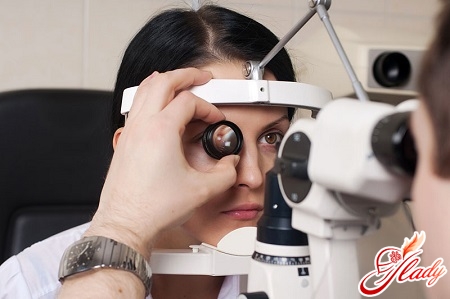
Myopia is an eye disease,which is accompanied by poor clarity of objects located far away. Depending on the severity, myopia can be weak, medium and high. According to the parameters of the course, there is progressive and non-progressive myopia. Constant and sharp progression leads to a significant decrease in visual acuity, and the form flows into malignant.
What is myopia or nearsightedness?
Myopia is considered a fairly common disorder.visual function of a person, therefore it is necessary to carefully monitor the health of the eyes, carry out preventive measures and start treatment of the disease in time. Otherwise, the disease becomes more severe, leads to the development of serious complications. The main causes of the disease are heredity, stress, increased intraocular pressure, unfavorable conditions, failure to comply with the rules of eye care. For example, when reading a book in a poorly lit room, reading in a lying position, excessively high eye strain, professional employment that requires close attention (working on a computer, making small drawings and sketches, studying printed materials, etc.).
Development of myopia
Treatment of myopia is largely determined by itsdegree. The degree is characterized by the distance of the focus from the retina itself. The higher the degree, the more difficult and time-consuming the treatment is. Up to 3 diopters is a weak degree, at which it is enough to follow simple advice, which helps to restore visual acuity. Up to 6 diopters is an average degree. And already over 6 diopters is high myopia, at which special treatment is already required, usually by surgery. The prognosis of correction depends on many factors (features of the structure of the eye elements, the presence of contraindications). It is not at all necessary that weak myopia will flow into a high degree. Very often, progressive myopia is a temporary phenomenon that is inherent in adolescence. As a rule, by the age of 20, the disease stops at a certain level and stops progressing. Only in isolated cases does the disease progress chronically and lead to disability. How can you independently determine the onset of this disease? To do this, it is necessary to undergo a regular medical examination of the body, since at the initial stage it is quite difficult to detect myopia without examination by specialists. This is due to the fact that for a long time the disease may not manifest itself in any way. The main symptom is deterioration of vision when observing objects located at a certain distance. At first, a person stops clearly seeing objects at a fairly large distance, later it becomes difficult to read a bus route, price tags in a store, watch TV, and so on. An accurate diagnosis is determined not only by a regular visual acuity test using a special table. As a rule, it is necessary to first dilate the pupil, which is called a state of cycloplegia. Very often, signs of false myopia can also occur with other visual impairments. It is also advisable to measure eye pressure, which allows you to exclude the presence of glaucoma. Only after a detailed and thorough examination of visual acuity, the state of the fiber and the fundus, special treatment is selected. As a rule, this is a set of measures due to which the patient's vision is corrected, restored or significantly improved. Without treatment, the situation will not improve, the disease will not disappear on its own.
Effective treatment of myopia
In each case, myopia (especially highdegree and constantly progressing) requires timely treatment. The most common methods are considered to be surgical intervention, conservative treatment, laser and contact correction. Conservative or drug treatment is used both for weak and for high degrees. First of all, to improve visual function, regular intake of vitamins and microelements is required. To relieve spasms, another group of drugs (irifrin, mesaton and others) are prescribed. To improve blood flow to brain tissue, piracetam or pentoskifylline is taken orally. Physiotherapy courses are also quite effective. These methods of reducing high degrees include laser therapy, magnetic therapy, specialized massage of the collar area. Contact and spectacle correction is the selection in each case of contact lenses or glasses depending on the severity of the disease. The most common lenses in modern times are those that allow you to lead an active lifestyle and do not cause a complex (as when wearing glasses). With a high degree, the lenses of glasses have fairly thick edges that worsen a person's appearance. But in some cases, lenses are strictly contraindicated. For example, they should be abandoned in case of inflammatory processes of the eyes, in case of an allergic reaction, in case of individual intolerance. In addition, improper care of contact lenses (rare cleaning, improper storage, exceeding the service life) can cause the development of various complications, which include keratitis. At the moment, orthokeratological glasses are used, which are used only at night. Of course, the peculiarity of this method of restoration is the temporary effect (although 100%). They give results only with mild or moderate myopia. Surgical intervention is indicated for myopia to stop the process of vision loss. Such an operation is usually called scleroplasty. At a high degree, the lens can be removed and replaced with a specially designed lens. Laser vision correction is the use of a laser, which performs the necessary manipulations. This method has a number of indications and contraindications. The main contraindications to such treatment are progressive myopia, age under 18, certain eye diseases (cataract, glaucoma, keratoconus), inflammatory processes, absence of the second eye, a thin enough cornea, some general diseases (autoimmune diseases, diabetes). Laser correction may have side effects, which are expressed in the form of dry eyes, conjunctivitis, hypo- or hypercorrection.
Prevention of visual impairment
Of course, high myopiacauses a lot of inconvenience, so mandatory correction and treatment are required. Timely referral to a specialist allows you to prevent the disease from progressing to other degrees of severity. Without treatment, irreversible reactions may occur, such as retinal dystrophy, uncorrectable decrease in visual acuity, hemorrhages and even retinal detachment. To prevent myopia from appearing, it is advisable to follow simple prevention rules. First of all, when reading a book or magazine, when working at a computer, when watching TV, the distance to the eyes should not be less than the length of an outstretched arm. In no case should you read in transport or in a lying position, as eye strain increases significantly. It is also necessary to maintain the quality of lighting during visual work. This leads to the fact that myopia of a weak degree appears. In sunny times of the year, it is advisable to select and wear high-quality sunglasses that protect the surface of the eye from harmful ultraviolet radiation. Myopia that has appeared requires mandatory correction, which is selected not independently, but after a complete examination of the patient.









